Abstract
Communication between a nanosatellite located in Low Earth Orbit (LEO) and a ground station is limited in regions far from the poles, occurring for only a few minutes on different days and at different times. By utilizing satellite-to-satellite communication, it is possible to transmit and receive information more efficiently, circumventing the restrictions inherent in satellite-ground station links. The objective of this study is to present a comparative report on the results of data transmission through inter-satellite and satellite-to-ground station communication, focusing on a 1U CubeSat nanosatellite (AztechSat-1). This paper discusses the use of the GlobalStar network and a nanosatellite for inter-satellite communication. This paper also discusses the use of proprietary and open-source ground stations for satellite-ground communication. We provide an overview of the GlobalStar network and the associated ground stations involved in this research, along with the results and their subsequent analysis.
1. Introduction
Today, small satellites in Low Earth Orbit are typically deployed as constellations to achieve global coverage. To ensure this coverage, hundreds or even thousands of satellites may need to be deployed [1]. Within the classification of small satellites based on weight, nanosatellites (1–10 kg) are one of the most popular categories. One commonly used standard in this category is the CubeSat, which is manufactured in a size of 10 × 10 × 10 cm3, also known as 1U [2].
Some advantages of manufacturing small satellites are as follows: cost reduction, short development times, launches at an affordable price, commercial applications, and flexibility [3]. Many projects today use commercial off-the-shelf (COTS) components and there are even companies that offer complete systems on the market [4].
Communication between satellites in Geostationary Orbit (GEO) and ground stations usually require large antennas with high transmit power, additionally, they present a high propagation delay due to the long propagation path [5].
Small satellites in LEO offer strategic advantages such as low propagation times, low propagation loss, as well as network robustness. In addition, the power required for data transmission and reception is lower [6].
The concept of satellite constellation is not new and emerged with pioneering companies such as Iridium and GlobalStar twenty years ago. They offered global communication link services that directly competed with cellular networks but had limited success due to high costs [7].
Satellite communication can be classified into two different groups. The first is based on a ground station network architecture, where information is transmitted from the satellite to a ground station and then relayed through existing ground links. This approach requires the deployment of numerous stations for global coverage [8]. The second type is based on a space-based network architecture, which utilizes intersatellite links between satellites and only requires a small number of gateways [9].
In this work, we present a hybrid approach where the GlobalStar constellation is based on the first type of architecture, while the AztechSat-1 nanosatellite is based on both the first and second types of architecture. In the first type, the nanosatellite allows communication with ground stations for radio amateurs, while in the second type, the nanosatellite establishes intersatellite links with the GlobalStar constellation, which subsequently relays the information to its gateways. The information transmitted remains the same in both cases.
There are some initiatives from Space Agencies to promote the use of space using CubeSat-based missions [10]. For example, the ESA Education Programme is composed of many hands-on projects, the Fly Your Satellite! (FYS) program is intended to give university students the opportunity to design, and launch and operate their own CubeSat [11]. On the other hand, NASA’s CubeSat Launch Initiative provides universities with the opportunity to launch small satellites into space, enabling students to gain hands-on experience in developing space hardware [12]. It is noteworthy to mention that the AztechSat-1 nanosatellite was part of NASA’s ELaNa 25B and 28 mission alongside other experiments such as CryoCube-1, SORTIE, CIRiS, and EdgeCube [13].
1.1. Description of the AztechSat-1 Nanosatellite
The project name, AztechSat-1, pays homage to the Aztec culture and represents the technological challenge it embodies. The AztechSat-1 is a nanosatellite belonging to the 1U CubeSat type category. It was developed by a multidisciplinary group of students from the Universidad Popular Autónoma del Estado de Puebla (UPAEP) in the state of Puebla, Mexico, in collaboration with the Mexican Space Agency (AEM) and the National Aeronautics and Space Administration (NASA). The satellite was launched on 5 December 2019, aboard a Falcon 9 launcher from Cape Canaveral and deployed from the International Space Station (IEE) using the NanoRacks CubeSat Deployer (NRCSD) on 19 February 2020, as shown in Figure 1. It remained operational until its re-entry on 10 December 2021.
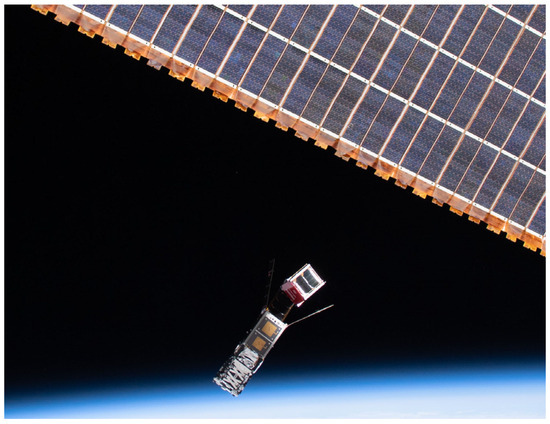
Figure 1.
AztechSat-1 deployed from the ISS on 19 February 2020 [14].
The primary objective of AztechSat-1, an academic nanosatellite, was to demonstrate communication between a nanosatellite and the GlobalStar constellation at a frequency within the L band (1611.25–1618.725 MHz), aiming to improve data transmission to Earth. Additionally, it aimed to promote amateur radio activities using ultra-high frequency (UHF) frequencies of 435 MHz for upload and 437 MHz for download. Figure 2 shows the mission operation diagram.
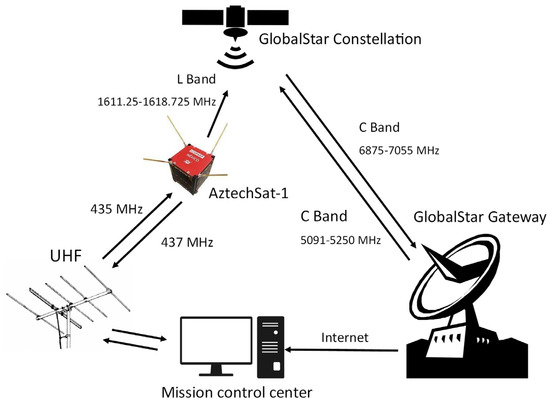
Figure 2.
AztechSat-1 mission operation diagram.
The AztechSat-1 nanosatellite is composed of an aluminum structure, an electrical power system (EPS), an on-board computer (OBC), an attitude determination and control system (ADCS), and a radio system for communication (COM) with the ground station in the amateur UHF frequency band. It also includes a communication module for intersatellite transmission in the L band. The system is equipped with a module that integrates the computer and the radio, as well as an interconnection panel for multipurpose boards. Additionally, it features an omnidirectional antenna system for communication with the ground station and is equipped with a set of 5 solar panels to provide power.
While the system incorporates commercial off-the-shelf (COTS) modules, the payload was specifically designed and manufactured to fulfill the mission objectives. Following its deployment, the nanosatellite powered on and initiated a countdown before transmitting its first packet of data, approximately 40 min later. Subsequently, the antennas were deployed, and the nanosatellite commenced its position control. Initially, the spacecraft was launched at an altitude of approximately 400 km with an inclination angle of 51.6°. The AztechSat-1 orbit simulation is described in Figure 3.
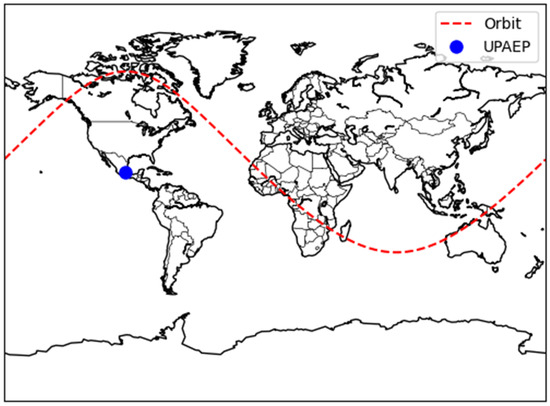
Figure 3.
AztechSat-1 orbit simulation.
1.2. Intersatellite Communication Description
To achieve the primary mission objective, the AztechSat-1 nanosatellite utilized GlobalStar’s Satellite Transmitter Integrated Global Positioning System Receiver (STINGR). This system incorporates a radio transmitter, a GPS receiver, and a patch antenna within a single integrated unit. Operating in simplex transmission mode, the STINGR system can communicate with the GlobalStar constellation. It automatically sends the data to the company’s gateways for transmission to the Internet.
For the main parameters of the STINGR communication module, please refer to Table 1. Any microcontroller with serial communication capabilities can use the modem.

Table 1.
Main parameters of the STINGR communication module [15].
1.3. Description of the GlobalStar Satellite Network
The GlobalStar satellite communication system operates in Low Earth Orbit and consists of a constellation of 48 satellites positioned at an approximate altitude of 1414 km. These satellites are distributed among eight planes, each accommodating six satellites, and follow circular orbits with an inclination of approximately 52 degrees. It is worth noting that the GlobalStar constellation is currently undergoing reorganization due to bankruptcy [16].
The original model of the GlobalStar constellation aimed to provide cost-effective and less complex communication solutions by utilizing a hub of ground stations without inter-satellite links (ISLs). The telemetry and command units were planned to be integrated into six host gateways, selected from a total of 200 stations distributed worldwide with redundancy. With an estimated coverage of 50% of the ground stations, each satellite would establish an average of one contact per orbit, which occurs within a period of approximately 10 to 12 min [17].
1.4. Description of the Global Network of SatNOGS Ground Stations
As part of the AztechSat-1 project, a ground station was established to fulfill the secondary objective of promoting activities among radio amateurs. In addition, this study encompasses an analysis of a full stack of open technologies based on open standards. The research uses data that was provided by the Satellite Networked Open Ground Station (SatNOGS) project, which provides access to open-source data contributed by radio amateurs.
Traditionally, when an individual or organization builds a ground station, especially for non-commercial purposes, the system remains inactive for extended periods of time. To maximize the utilization of these resources, projects have been developed to enable their use by multiple users. The SatNOGS project facilitates the connection to a network of open-source ground stations, designed with modularity in mind. This network allows users to access satellite information uploaded by different individuals through a user-friendly web interface. Real-time information from numerous registered ground stations can be obtained through this network. To be compatible with the network, a ground station must have client software installed on an embedded computer. Additionally, a software-defined radio (SDR) should be connected to the computer and properly configured to work with SatNOGS [18].
1.5. State of the Art
The current predominant approach for communication between CubeSats and commercial intersatellite link networks in Low Earth Orbit is based on systems such as Iridium, GlobalStar, and Orbcomm [19].
In a 2008 investigation analyzing Inmarsat, Thuraya, Iridium, and GlobalStar, it was concluded that the GlobalStar network is best suited for nanosatellite payloads with an inclination of 52 degrees at altitudes ranging from 300 to 600 km [20].
TechEdSat 4, launched in 2014, also utilized a communication module for GlobalStar. Although it operated nominally, information regarding its results is unavailable. On August 2016, the secondary payload “exo-brake” was deployed resulting in early orbital reentry [21]. The PicoPanther project has been studying the GlobalStar and Iridium networks since 2008, with its approach remaining controversial until the launch of PhoneSats, particularly PhoneSat 1 Bell [22].
TechEdSat 8, deployed from the International Space Station on 31 January 2019, featured an integrated Near-Earth Network (NEN) S-band radio compatible with Iridium and GlobalStar transmitters. However, it was unable to undergo testing after deployment due to an onboard power system abnormality [23].
In the nanosatellite database (www.nanosats.eu (accessed on 11 September 2023)), there are at least 40 registered CubeSat-type nanosatellites that utilize a GlobalStar-compatible communication module as their primary or secondary downlink band. However, some of these projects were either not released or were subsequently cancelled. Among notable success stories are TSAT, GEARRSSAT, CubeRRT, MakerSat1, and AztechSat-1 [24].
The results of TSAT, a 2U CubeSat, demonstrated the effectiveness of the GlobalStar commercial network without the need for a ground station. The satellite’s objective was to validate and characterize the link capacity of the GlobalStar constellation and conduct measurements in an Extremely Low Earth Orbit (ELEO). The team recorded successful simplex link transmissions within the field of view of the patch antenna. TSAT data was received by one or more GlobalStar satellites and transmitted to a gateway. The team received a total of 21,154 packets and noted that the system was capable of transmitting thousands of packets per day on a CubeSat. Although the quantitative capacity was not explored. At the beginning of the mission, TSAT transmitted its maximum number of messages, recording 26 dual-packet messages in 18 min. After ten days, this number was reduced to 7 messages per hour. The system implemented an STX-2 module and was deployed into a circular orbit at 325 km with an inclination of 51.6 degrees [25].
2. Materials and Methods
2.1. Description of the Received Data (SatNOGS and GlobalStar)
For the intersatellite transmission system, a 32-bit Cortex M3 ARM microcontroller was utilized to control the STINGR simplex transmission device, which was equipped with an STX3 modem. This configuration allowed the transmission of packets to a network of LEO satellites using the GlobalStar network. The received data is then forwarded to a web interface where the user interprets the data for further processing.
The device sends a signal to one or more nearby satellites without knowing exactly which satellite will receive the signal. Subsequently, the GlobalStar satellites download the information to the nearest Gateway. Redundant messages are discarded. Each message consists of 9-byte data packets, meaning that the system can transmit only 9 bytes in a single message. Therefore, if the message is larger, multiple packets need to be sent. There is a possibility of message loss when no satellite is within range. As the system operates in simplex mode, a redundancy method is employed to increase the probability of successful message reception.
The information received by the satellite and transmitted to the gateways was presented in a raw log report generated in Excel format. The received packets were placed in different cells using a standardized JSON format. Depending on the configuration 2 or more packets make up a message. A valid message has a length of 157 bytes starting with a marker “<HK>” and ending with “</HK>”.
2.2. Description of the Software Developed and Used for the Analysis of the Results
The information sent by the AztechSat-1 and received by the GlobalStar gateways is transmitted in a custom format, needing the development of a computer program to automatically count, categorize, and decode the received messages. AztechSat-1 transmits various parameters such as temperatures of different solar panels, battery voltage, current, and other relevant data. The system data dictionary, providing a comprehensive list of these parameters, can be found in Table 2.

Table 2.
Description of transmitted parameters categorized by subsystem.
Figure 4 shows the nanosatellite received packets using the GlobalStar link throughout the entire mission. The chart provides a summary of packets categorized by their size in bytes. The transmission rate of messages is grouped into sets of 9-byte packets, with each transmission containing 1 to 16 packets. This allows a maximum of 144 bytes to be transmitted in a single uninterrupted burst. The geographic distribution of the AztechSat-1 packets is shown below in Figure 5 using GlobalStar communication.
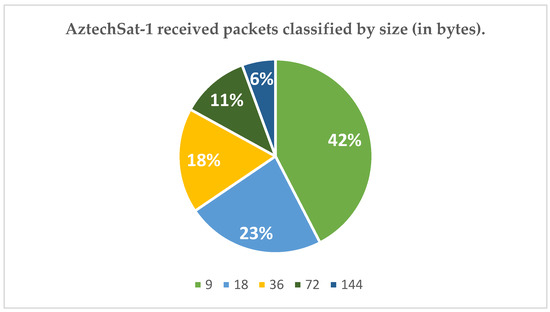
Figure 4.
Received packets categorized by size (in bytes).
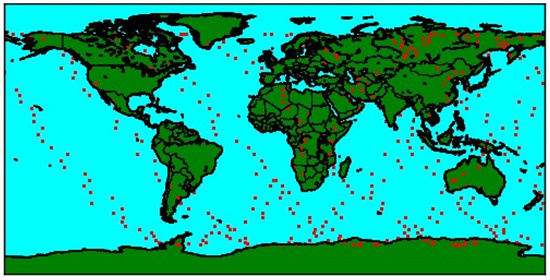
Figure 5.
Geographic distribution of received packets from the AztechSat-1 using GlobalStar, the red dots represent regions where packets where received.
For the ground station-based system, the AztechSat-1 nanosatellite utilized a half-duplex radio operating at a UHF frequency that was compatible with the ASM + Golay protocol and offered Gaussian Frequency Shift Keying (GFSK) modulation options. The communication with the onboard computer was facilitated through the I2C communication protocol. The nanosatellite was equipped with a 50-ohm matched omnidirectional antenna, providing a gain of 1.5 dBi at −1 dBi. The use of UHF made it possible to collect data from the university’s ground station and the SatNOGS network.
Throughout the operational period of AztechSat-1, SatNOGS received a total of 500 beacon packets. These packets were subsequently processed to extract and interpret the information they contained. On 10 December 2021, the AztechSat-1 nanosatellite reentered Earth’s atmosphere, which is evidenced by numerous reports of telemetry available on Twitter and SatNOGS. In Figure 6 and Figure 7 the altitudes and speeds of the last days in orbit of the nanosatellite can be observed.
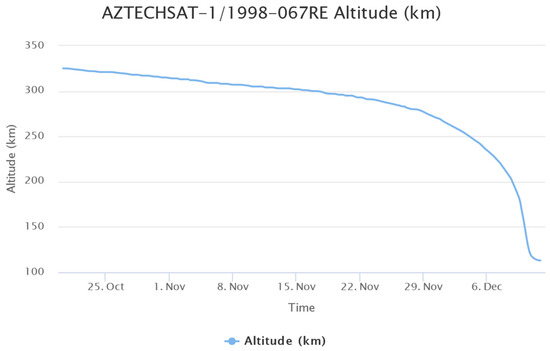
Figure 6.
Altitude of the AztechSat-1 during its last days in orbit [26].
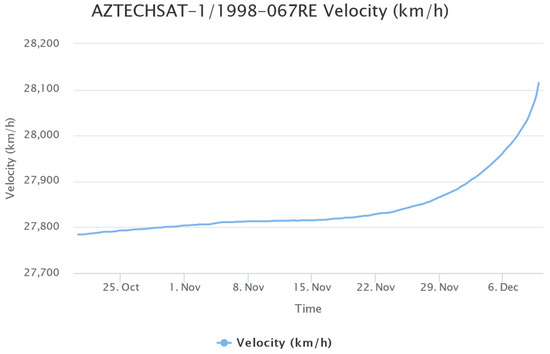
Figure 7.
Velocity of the AztechSat-1 during its last days in orbit [26].
2.3. Strategies for the Use of Statistical Tools, Graphs, among Others for the Presentation of Results
To download data from SatNOGS, it is necessary to register as a user on the SatNOGS DB page. Once registered, users can request the export of all received frames to a CSV file using the API. This CSV file will contain each received frame along with its corresponding reception time, with each frame listed on a separate line.
3. Results
As previously mentioned, the AztechSat-1 nanosatellite is an academic experiment in the form of a 1U CubeSat. Although it was equipped with an integrated GPS system, its high-power consumption requirements prevented its use during the mission. Consequently, the tracking of the satellite was achieved using NORAD Two-Line Elements (TLEs) shown in Table 3, which served as the primary element for satellite tracking throughout the mission.

Table 3.
NORAD Two-Line Element of the AztechSat-1.
3.1. Analysis of Data Received from GlobalStar and SatNOGS
The temperature variations obtained in the month of July 2020 using only the system based on intersatellite communication can be seen in Figure 8 and Figure 9. The location of the sensors is in each of the solar panels for external temperatures and on the onboard computer, electrical power system, and radio boards for internal temperatures.
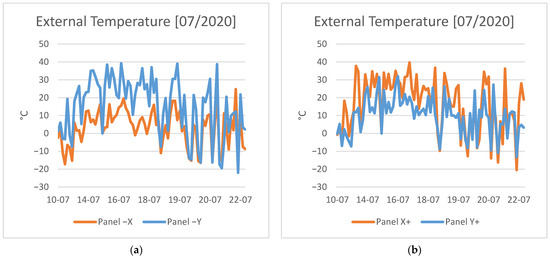
Figure 8.
Temperature variations on the external panels of the nanosatellite: (a) Temperature variations on panels −X and −Y; (b) Temperature variations on panels X+ and Y+.
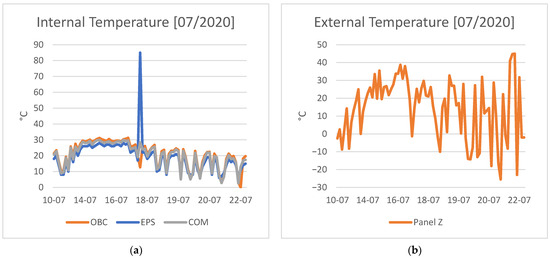
Figure 9.
Temperature variations on internal and external components: (a) Temperature variations on internal boards of the satellite; (b) Temperature variations on solar panel Z.
These figures depict the temperature variations observed during one month of satellite operation. Throughout this period, the satellite experienced maximum and minimum temperatures of 45 °C and −25 °C respectively in the external environment. The internal temperatures ranged from 0 °C to 30 °C, with an abnormal data point of 85 °C on 18 July 2020 possibly indicating an error in reading the sensor or a component failure as shown in Figure 9a.
Figure 10 illustrates the relationship between the battery voltage and the input and output current of the EPS system. The behavior of the battery voltage can be observed in comparison to the levels of input and output current. It is evident that the battery charging process occurs when the input current surpasses the output current. Additionally, an anomaly in the charge level is noticeable, potentially correlated with the anomaly depicted in the internal temperature as shown in Figure 9a.

Figure 10.
Relationship between battery voltage and input and output Current.
3.2. Analysis of the Results Classified by Inter-Satellite Ground Station
Figure 11 indicates the temperature variations observed in 2021, using the ground station communication system exclusively with data obtained from SatNOGS. The temperature information collected through this system is similar to the obtained through intersatellite link communication.
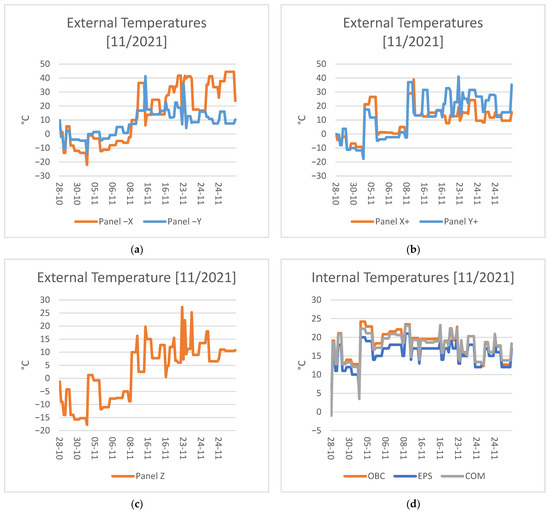
Figure 11.
Temperature variations on internal and external components in November 2021: (a) Temperature variations on solar panels −X and −Y; (b) Temperature variations on solar panels X+ and Y+; (c) Temperature variations on solar panels Z.; (d) Temperature variations on internal boards of the nanosatellite.
Figure 11a–c illustrates the exterior temperatures recorded in November 2021, and received via radio frequency (RF) through the SatNOGS platform. Comparing it with the information received via GlobalStar in July 2020, the exterior temperature demonstrates a comparable pattern, with minimums and maximums remaining within the range of −30 °C and 50 °C, respectively.
Figure 11d illustrates the interior temperature recorded in November 2021, this data was received via radio frequency (RF) through the SatNOGS platform. Comparing it with the information received via GlobalStar in July 2020, the internal temperatures demonstrate a comparable pattern, with minimums and maximums that remain between −1 °C and 32 °C. The information on the internal temperatures was recorded using sensors located in the OBC, EPS, and radio.
Figure 12 depicts the behavior of the battery voltage during the month of September 2021. After one and a half years of operation, it can be observed that the charging periods have extended, while the system’s current consumption has reduced.
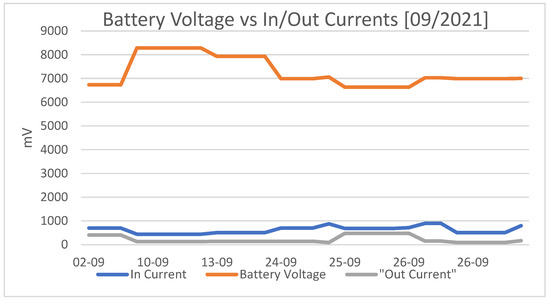
Figure 12.
Voltages and currents of the nanosatellite, captured in September 2021.
It is important to note that the information transmitted through GlobalStar and received by SatNOGS is similar, highlighting the reliability of telemetry data obtained through both communication methods. However, in the case of satellite-to-satellite communication (via GlobalStar), it turned out to be better because more points of data were retrieved. In the case of GlobalStar communication, different packet length configurations were utilized. The GlobalStar modem has five options for the packet length starting at 9 bytes per packet. The biggest packet length is 144 bytes per packet.
3.3. Analysis of Data Received from GlobalStar and Ground Stations
The obtained information from GlobalStar and different ground stations was compared to assure reliability. To do this comparison we took samples of data collected from the ground stations where the data from GlobalStar were coincident on date and time. Figure 13 depicts charts where the similarity between the data received by RF and GlobalStar is confirmed.
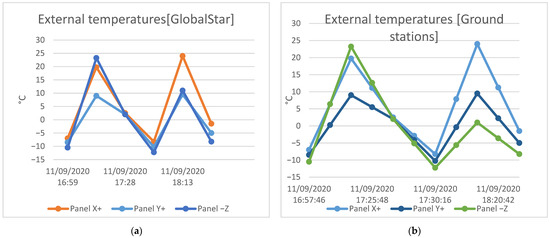
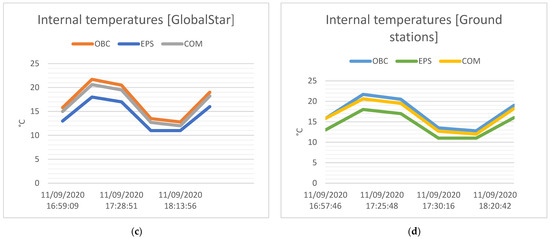
Figure 13.
Temperature variations on internal and external components on 11 September 2020 using data from ground-to-satellite link and satellite-to-satellite link: (a) Temperature variations on solar panels −X, −Y and −Z using data received by GlobalStar; (b) Temperature variations on solar panels −X, −Y and −Z using data received by ground stations; (c) Temperature variations on internal boards of the satellite using data received by GlobalStar; (d) Temperature variations on internal boards of the satellite using data received by ground stations.
The telemetry data was collected by both ground stations and GlobalStar. The obtained results show more information via ground stations than via GlobalStar satellites. The GlobalStar data indicated a delay in comparison with the ground station data.
For satellite-to-satellite communication, different packet length configurations were set up. The GlobalStar modem has five options for the packet length starting at 9 bytes with increments of 9 bytes. The biggest packet length is 144 bytes. The sent message containing the housekeeping data of the nanosatellite has a length of 157 bytes and each packet has 2 bytes with information for message reassembling. This means that for a 9 bytes packet length configuration, 23 packets were needed to reassemble the message; and for a 144 bytes packet length configuration, only 2 packets were needed.
Table 4 presents the result obtained with each packet length configuration. It can be observed that the configuration of 144 bytes per packet has the biggest success rate. Success rate refers to the relationship between received messages and decoded messages. The reason why messages could not be decoded was mainly because fragments were missing and the message could not be reassembled.

Table 4.
Results obtained with different configurations of message length.
It is important to note that with the smallest packet length configuration (9 bytes per packet), 5246 packets were received, out of which only 145 messages could be identified. However, all these messages were missing fragments, making it impossible to decode them. On the other hand, with the largest message length configuration (144 bytes per packet), 692 packets were received, out of which 135 messages were identified, and only 60 arrived complete.
The smallest packet length configuration resulted in more valid received packets, however, most of the fragments were lost. When the message was increased, the complexity of reassembling the message at the receiver’s end was reduced. This is why, despite receiving more valid packets, very few messages were successfully reconstructed, as many fragments were missing. With the largest packet length configuration, we received fewer valid packets but the probability of recovering the whole message was higher.
Table 4 shows the results obtained with each of these configurations. As shown, the reception success rate improves as the message length increases. This suggests that less fragmented transmitted messages are less susceptible to loss of data fragments.
4. Discussion
The use of services with global coverage like GlobalStar as a link to download data from space seems to be a good alternative to other traditional forms of communication such as ground-to-satellite communication. Beyond traditional radiofrequency links, these services including GlobalStar, Starlink, and Iridium, offer unprecedented global reach, low-latency connections, and reliability that are essential for a broad spectrum of space missions. Their cost-effectiveness, scalability, and ease of deployment make them an attractive option for data transfer in remote or challenging space environments.
In this work, we study the idea of enhancing ground-to-satellite communication with satellite-to-satellite links. Our results show a better performance of data covering more geographical areas using intersatellite communication than only using ground station communication.
So far, successful mission and the current literature shows little information in a brief period in similar orbits. The AztechSat-1 project has demonstrated two kinds of satellite communication which have enhanced the received data. Data obtained from GlobalStar has increased the amount of information in comparison to only ground-satellite communication.
In our future work, we will study the performance of a constellation of proprietary nanosatellites with a commercial constellation in an environment that involves real-world constraints. Our next step is a collaborative initiative between the Mexican Space Agency and the National Aeronautics and Space Administration which is currently underway to develop a constellation of at least four nanosatellites for animal telemetry applications. This joint project has been named the AztechSat Constellation. Its primary objective is to establish a marine fauna monitoring system. The project will involve professors and students from various Mexican universities, who will contribute their expertise to the design and integration of nanosatellites for deployment in Low Earth Orbit.
5. Conclusions
The results obtained throughout the operational lifespan of the AztechSat-1 nanosatellite offer valuable insights. Firstly, they serve to validate temperature data obtained from a nanosatellite in a Low Earth Orbit, providing a comprehensive understanding of temperature patterns in such an orbital environment. Additionally, the energy consumption pattern of a communication nanosatellite can be identified.
Moreover, the study highlights the effectiveness of the GlobalStar commercial network in intersatellite links, demonstrating its capability without the need for a ground station. A comparison is made between the quality of data obtained through the GlobalStar network and that acquired using open-source ground stations with the support of radio amateurs, employing the same satellite at different time periods.
The conclusions drawn from both forms of communication are presented. It is noted that packet length demonstrated improved performance in intersatellite communication. Furthermore, the analysis examines whether ground stations provided additional information beyond that gathered by SatNOGS.
Author Contributions
Conceptualization, H.S.V.-M.; writing—original draft preparation, H.S.V.-M., N.Q.-H. and S.E.M.-R.; writing—review & editing, M.L.-G. and E.R.G.-S.; methodology M.L.-G. and E.R.G.-S.; formal analysis M.L.-G. and E.R.G.-S.; project administration, H.S.V.-M.; validation, N.Q.-H. and S.E.M.-R.; supervision, N.Q.-H. and S.E.M.-R. All authors have read and agreed to the published version of the manuscript.
Funding
This study was mainly supported by a sectoral fund for Research, Technological Development, and Innovation in Space Activities AEM-CONACYT. Project number: 292767 under the title “Diseño y construcción del módulo de enlace intersatelital AztechSat-1–GlobalStar”, a Council of Science and Technology of the State of Puebla (CONCYTEP) fund. Project number 08 Bis/2018 under the title “Diseño y construcción del Módulo de Enlace Intersatelital “AzTechSat-1”–GlobalStar, an internal budget from UPAEP, a non-profit university located in Puebla, Mexico, since year 2017 to 2019, as a part of a continuing education project for students from the Electronics department for the CubeSat subsystems acquisition, development, and manufacturing.
Data Availability Statement
Not applicable.
Acknowledgments
We would like to express our sincere gratitude to the dedicated students and professors of the Universidad Popular Autónoma del Estado de Puebla for their significant contributions in ensuring the success of the AztechSat-1 project. We are immensely thankful to the Mexican Space Agency for their unwavering support and guidance throughout the development of the nanosatellite. Our heartfelt appreciation also goes to NASA for their invaluable assistance in launching, testing, and sharing their expertise, as well as for their generous commitment of time in addressing our queries. We extend our gratitude to the National Council of Humanities Science and Technology in Mexico (CONAHCYT) for their support in providing scholarships for human resources training and resources to fulfill the project’s requirements. We are grateful to the Benemérita Universidad Autónoma de Puebla (BUAP) and the Instituto Nacional de Astrofísica, Óptica y Electrónica (INAOE) for their assistance in conducting various tests and experiments.
Conflicts of Interest
The authors declare no conflict of interest.
References
- He, G.; Gao, X.; Sun, L.; Zhang, R. A Review of Multibeam Phased Array Antennas as LEO Satellite Constellation Ground Station. IEEE Access 2021, 9, 147142–147154. [Google Scholar] [CrossRef]
- Sinha, R.; Verma, A.; Choudhary, S. General Analysis of Cube Satellite Technology: An Overview. Int. J. Comput. Appl. 2019, 178, 19–22. [Google Scholar] [CrossRef]
- Malisuwan, S.; Kanchanarat, B. Small Satellites for Low-Cost Space Access: Launch, Deployment, Integration, and In-Space Logistics. Am. J. Ind. Bus. Manag. 2022, 12, 1480–1497. [Google Scholar] [CrossRef]
- Yaqoob, M.; Lashab, A.; Vasquez, J.C.; Guerrero, J.M.; Orchard, M.E.; Bintoudi, A.D. A Comprehensive Review on Small Satellite Microgrids. IEEE Trans. Power Electron. 2022, 37, 12741–12762. [Google Scholar] [CrossRef]
- Kolawole, M.O. Satellite Communication Engineering; CRC Press: Boca Raton, FL, USA, 2017. [Google Scholar]
- ITU-R. Simulation Methodologies for Determining Statistics of Short-Term Interference between Co-Frequency, Codirectional Non-Geostationary-Satellite Orbit Fixed-Satellite Service Systems in Circular Orbits and Other Non-Geostationary Fixed-Satellite Service Systems in Circular Orbits or Geostationary-Satellite Orbit Fixed-Satellite Service Networks; International Telecommunication Union: Geneva, Switzerland, 2003. [Google Scholar]
- Curzi, G.; Modenini, D.; Tortora, P. Large Constellations of Small Satellites: A Survey of Near Future Challenges and Missions. Aerospace 2020, 7, 133. [Google Scholar] [CrossRef]
- Tanenbaum, A.S. Network Protocols. ACM Comput. Surv. 1981, 13, 453–489. [Google Scholar] [CrossRef]
- Budenske, J.R.; Millikin, K.S.; Bonney, J.C.; Ramanujan, R.S.; Sands, O.S. Space network architecture technologies. In Proceedings of the 2002 IEEE Aerospace Conference Proceedings, Big Sky, MT, USA, 9–16 March 2002; Volume 3, pp. 3–1061. [Google Scholar]
- Camps, A. Nanosatellites and Applications to Commercial and Scientific Missions. In Satellites Missions and Technologies for Geosciences; IntechOpen: Rijeka, Croatia, 2019; ISBN 978-1-78985-996-6. [Google Scholar]
- Marée, H.; Galeone, P.; Kinnaird, A.; Callens, N. The ESA Education Programme and Its ESA Academy; University of Leicester: Leicester, UK, 2020; ISBN 978-1-912989-09-6. [Google Scholar]
- Crusan, J.; Galica, C. NASA’s CubeSat Launch Initiative: Enabling broad access to space. Acta Astronaut. 2019, 157, 51–60. [Google Scholar] [CrossRef]
- National Aeronautics and Space Administration: Past ElaNa CubeSat Launches. CubeSat Launch Initiative. 2021. Available online: https://www.nasa.gov/content/past-elana-cubesatlaunches (accessed on 17 August 2023).
- Tabor, A. What Is AzTechSat-1? Available online: http://www.nasa.gov/ames/aztechsat-1 (accessed on 18 August 2023).
- Garcia, J. Telemetry Subsystem with Higher Access Duration for LEO Satellites; Morehead State University: Morehead, KY, USA, 2018. [Google Scholar]
- Butash, T.; Garland, P.; Evans, B. Non-geostationary satellite orbit communications satellite constellations history. Int. J. Satell. Commun. Netw. 2021, 39, 1–5. [Google Scholar] [CrossRef]
- Smith, D.; Hendrickson, R. Mission control for the 48-satellite Globalstar constellation. In Proceedings of the IEEE MILCOM ’95, San Diego, CA, USA, 5–8 November 1995; Volume 2, pp. 828–832. [Google Scholar]
- Croissant, K.; White, D.; Álvarez, X.C.; Adamopoulos, V.; Bassa, C.; Boumghar, R.; Brown, H.; Daradimos, I.; Dohmen, P.; Flawinne, J.; et al. An Updated Overview of the Satellite Networked Open Ground Stations (SatNOGS) Project; Utah State University: Logan, UT, USA, 2022. [Google Scholar]
- Al-Hraishawi, H.; Chougrani, H.; Kisseleff, S.; Lagunas, E.; Chatzinotas, S. A Survey on Nongeostationary Satellite Systems: The Communication Perspective. IEEE Commun. Surv. Tutor. 2023, 25, 101–132. [Google Scholar] [CrossRef]
- Khan, K. Data Communication with a Nano-Satellite Using Satellite Personal Communication Networks (S-Pcns). Master’s Thesis, University of Central Florida, Orlando, FL, USA, 2007. [Google Scholar]
- Murbach, M.; Alena, R.; Luna, A.G. The TechEdSat/PhoneSat Missions for Small Payload Quick Return. In Proceedings of the Small Satellite Conference, Logan, UT, USA, 6–11 August 2016; Utah State University: Logan, UT, USA, 2016. [Google Scholar]
- Rodriguez, C.; Boiardt, H.; Bolooki, S. CubeSat to commercial intersatellite communications: Past, present and future. In Proceedings of the 2016 IEEE Aerospace Conference, Big Sky, MT, USA, 5–12 March 2016; pp. 1–15. [Google Scholar]
- Wong, Y.; Schaire, S.; Bundick, S.; Kegege, O.; Altunc, S.; Fetterer, P.; Murbach, M.; Priscal, C.; Perrotto, T.; Celeste, P. NASA Near Earth Network (NEN) DVB-S2 Demonstration Testing for Enhancing Data Rates for CubeSat/SmallSat Missions. In Proceedings of the Annual Conference on Small Satellites, Logan, UT, USA, 3–8 August 2019. [Google Scholar]
- Kulu, E. Nanosats Database. Available online: https://www.nanosats.eu/index.html (accessed on 1 August 2023).
- Voss, H.D.; Dailey, J.F.; Crowley, J.C.; Bennett, B.; White, A.J. TSAT Globalstar ELaNa-5 Extremely Low-Earth Orbit (ELEO) Satellite. In Proceedings of the 28th Annual AIAA/USU Conference on Small Satellites, Logan, UT, USA, 14–16 October 2014; American Institute of Aeronautics and Astronautics: Reston, VA, USA, 2014. [Google Scholar]
- Orbit.ing-now.com AZTECHSAT-1/45261/1998-067RE. Available online: https://orbit.ing-now.com/satellite/45261/1998-067re/aztechsat-1/ (accessed on 20 October 2023).
Disclaimer/Publisher’s Note: The statements, opinions and data contained in all publications are solely those of the individual author(s) and contributor(s) and not of MDPI and/or the editor(s). MDPI and/or the editor(s) disclaim responsibility for any injury to people or property resulting from any ideas, methods, instructions or products referred to in the content. |
© 2023 by the authors. Licensee MDPI, Basel, Switzerland. This article is an open access article distributed under the terms and conditions of the Creative Commons Attribution (CC BY) license (https://creativecommons.org/licenses/by/4.0/).